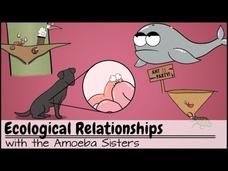Be Smart
These Butt-Tickling Ants Are Endangered Butterfly Bodyguards | IN OUR NATURE
Seemingly distant ecosystems, even half a world apart, are connected in surprising ways. In this special limited series, Emily Graslie and Trace Dominguez join me as we explore the universal rules of life that tie together Earth’s living...
SciShow
Parasites Are Good, Actually
Parasites give most of us the heebie-jeebies. But new research shows they're pretty dang important for ecosystems, and climate change is putting them in danger. So here's some of the reasons you should care about those guys!
TED-Ed
TED-Ed: Would you raise the bird that murdered your children? | Steve Rothstein
A mother honeyguide has placed its chick into a bee-eater's nest— puncturing all the other eggs in the nest and leaving only its own hatching alive. Over the following weeks, the host parents devotedly care for the hatchling whose mother...
Amoeba Sisters
Ecological Relationships
Explore several ecological relationships with The Amoeba Sisters! Ecological relationships discussed include predation, competition, and symbiotic relationships (parasitism, mutualism, and commensalism). Table of Contents: Intro 00:00...
SciShow
6 of the Oldest Parasites Ever Found
Where there's life, there's other life looking for a free ride. Here are six of the world's oldest parasites.
SciShow
Human Parasites
Hank tells us about all of the things that live on us or in us - the good, the bad, and the very, very ugly.
Bozeman Science
Populations
Paul Andersen explains how populations interact in an ecosystem. The symbiosis of several populations is based on effects that may be neutral, positive, or negative. Interactions like mutualism, commensalism and parasitism are included....
SciShow
Symbioses Are Way More Complex Than You Think!
When we hear the term symbiosis, we tend to think about a simple partnership between two biological organisms. But in many cases, there are more than two parties involved and it's way more complicated.
Crash Course
Community Ecology II: Predators - Crash Course Ecology
Hank gets to the more violent part of community ecology by describing predation and the many ways prey organisms have developed to avoid it.
Professor Dave Explains
Behavioral Ecology (Foraging, Parasitism, Mutualism, Mate Choice, and Social Groups)
With a better understanding of ecosystems and their habitats, we are ready to discuss behavioral ecology. This looks at how organisms interact and how this effects the ecosystem. What is foraging? What about parasitism, or mutualism? How...
Curated Video
What is Symbiosis?
Symbiosis is relationship where two different species co-exist and at least one derives benefit from the other. The name for an organism with a symbiotic relationship is a symbiont. Let's look at some examples of symbiotic relationships.
Brave Wilderness
Removing a Face Parasite!
If you don’t already have a skincare routine, it might be time to pick one up, because once you see this… you can’t unsee it. This week, Mark and Dr. Hunter Hines, a Microbial Ecologist, are getting face-to-face with face parasites....
Next Animation Studio
Newly discovered fungi turn flies into parasite-spewing zombies
Two new species of fungi have been discovered that devour flies from the inside and cause them to release spores from holes in their abdomens, according to research published in the Journal of Invertebrate Pathology
Curated Video
Understanding Habitats, Niches, and Symbiotic Relationships in Ecology
This section covers the relationship between organisms and their environment. It also covers the Levels of Organization and symbiotic relationships.
msvgo
Population Interactions
Explain the different types of intraspecific and interspecific interactions among organisms with examples.
Bozeman Science
Populations
The largest concentration of free-roaming wildlife in the continental United States is found in Yellowstone National Park. A video describes the three main types of population interactions: mutualism, commensalism, and parasitism. It...
Scholastic
Study Jams: Symbiosis
Three types of symbiosis are explained: parasitism, commensalism, and mutualism. This is done with colorful animation and lively dialogue in a straightforward and easy-to-follow manner. Have your ecology class watch this at home and then...
Curated OER
Populations
Every species in the world has some type of relationship with another species, whether it be positive, negative, or neutral for each party. Mr. Andersen defines each type of relationship and provides clear examples under each category....
Amoeba Sisters
Ecological Relationships
What are ecological relationships? Well, it can be complicated! Paint a clear picture for pupils with a fun and informative video. It explains and illustrates each relationship thoroughly, from pesky parasites to snuggly symbiotes.
The Brain Scoop
The Case for Saving Parasites
One study found there could be as many as 30,000 species of parasitic worms. Very few scientists study parasites, yet the need for a better understanding continues to prove itself. Brain Scoop presents a strong case for studying and...
Kurzgesagt – In a Nutshell
The Death Of Bees Explained—Parasites, Poison and Humans
Maybe instead of humans dying off from a war, they will die as a result of a lack of food. The video discusses this possibility and why it is becoming more likely. It explains the importance of bees and the many different ways humans...
Teacher's Pet
Species Interactions
Every species competes for food. The video explains interspecific competition, intraspecific competition, and the competitive exclusion principle as a part of predator-prey relationships. It also covers resource partitioning and the...
Deep Look
What Gall! The Crazy Cribs of Parasitic Wasps
It turns out some wasps have a lot of gall! An engaging video lesson presents parasitism at its finest. Certain species of wasps trick oak trees into creating and maintaining homes for their larva. These homes have the appropriate name...







